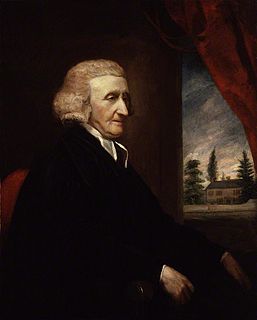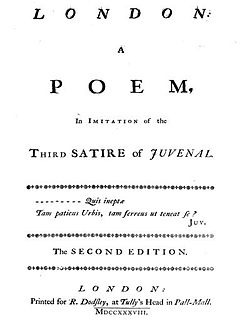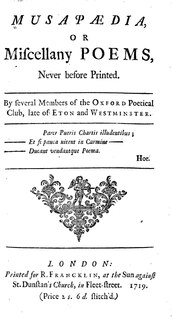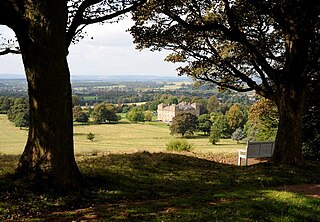Related Research Articles

Robert Dodsley was an English bookseller, publisher, poet, playwright, and miscellaneous writer.
This article is a summary of literary events and publications during 1764.

Anna Seward was an English Romantic poet, often called the Swan of Lichfield. She benefited from her father's progressive views on female education.

Halesowen is a market town in the Metropolitan Borough of Dudley, in the county of West Midlands, England. It is considered one of the largest towns in the United Kingdom without a railway station.

William Shenstone was an English poet and one of the earliest practitioners of landscape gardening through the development of his estate, The Leasowes.

The Leasowes is a 57-hectare estate in Halesowen, historically in the county of Shropshire, England, comprising house and gardens. The parkland is now listed Grade I on English Heritage's Register of Parks and Gardens and the home of the Halesowen Golf Club. The name means "rough pasture land".

Richard Jago was an English clergyman poet and minor landscape gardener from Warwickshire. Although his writing was not highly regarded by contemporaries, some of it was sufficiently novel to have several imitators.

Richard Graves was an English cleric, poet, and novelist. He is remembered especially for his picaresque novel The Spiritual Quixote (1773).

Thomas Percy was Bishop of Dromore, County Down, Ireland. Before being made bishop, he was chaplain to George III of the United Kingdom. Percy's greatest contribution is considered to be his Reliques of Ancient English Poetry (1765), the first of the great ballad collections, which was the one work most responsible for the ballad revival in English poetry that was a significant part of the Romantic movement.

The Clent Hills lie 10 miles (16 km) south-west of Birmingham city centre in Clent, Worcestershire, England. The closest towns are Stourbridge and Halesowen, both in the West Midlands conurbation. The Clent Hills range consists of, in order from north-west to south-east: Wychbury Hill, Clent Hill, and Walton Hill. The north Worcestershire range of hills continues eastwards to include Romsley Hill, Waseley Hills and the Lickey Hills.

London is a poem by Samuel Johnson, produced shortly after he moved to London. Written in 1738, it was his first major published work. The poem in 263 lines imitates Juvenal's Third Satire, expressed by the character of Thales as he decides to leave London for Wales. Johnson imitated Juvenal because of his fondness for the Roman poet and he was following a popular 18th-century trend of Augustan poets headed by Alexander Pope that favoured imitations of classical poets, especially for young poets in their first ventures into published verse.

The Vanity of Human Wishes: The Tenth Satire of Juvenal Imitated is a poem by the English author Samuel Johnson. It was written in late 1748 and published in 1749. It was begun and completed while Johnson was busy writing A Dictionary of the English Language and it was the first published work to include Johnson's name on the title page.

The literary tradition of Birmingham originally grew out of the culture of religious puritanism that developed in the town in the 16th and 17th centuries. Birmingham's location away from established centres of power, its dynamic merchant-based economy and its weak aristocracy gave it a reputation as a place where loyalty to the established power structures of church and feudal state were weak, and saw it emerge as a haven for free-thinkers and radicals, encouraging the birth of a vibrant culture of writing, printing and publishing.
John Scott Hylton was an English antiquary and poet, and a member of the Shenstone circle of writers that gathered around the poet and landscape gardener William Shenstone.
John Prynne Parkes Pixell was an English poet, priest and composer.
Mary Darwall, who sometimes wrote as Harriett Airey, was an English poet and playwright. She belonged to the Shenstone Circle of writers gathered round William Shenstone in the English Midlands. She later explored subjects that included the nature of female friendship and the place of women writers.

A miscellany is a collection of various pieces of writing by different authors. Meaning a mixture, medley, or assortment, a miscellany can include pieces on many subjects and in a variety of different forms. In contrast to anthologies, whose aim is to give a selective and canonical view of literature, miscellanies were produced for the entertainment of a contemporary audience and so instead emphasise collectiveness and popularity. Laura Mandell and Rita Raley state:
This last distinction is quite often visible in the basic categorical differences between anthologies on the one hand, and all other types of collections on the other, for it is in the one that we read poems of excellence, the "best of English poetry," and it is in the other that we read poems of interest. Out of the differences between a principle of selection and a principle of collection, then, comes a difference in aesthetic value, which is precisely what is at issue in the debates over the "proper" material for inclusion into the canon.

Henrietta Knight, Baroness Luxborough, was an English poet and letter writer, now mainly remembered as a gardener. She married the rising politician Robert Knight in 1727, but he banished her to his estate at Barrells Hall in 1736 as punishment for a romantic indiscretion. Horace Walpole's correspondence suggests she was caught by her husband in flagrante delicto with her doctor, whilst other sources add a further lover in the form of a young cleric named John Dalton (1709–1763).

Hagley Park is the estate of Hagley Hall in Worcestershire, England. The grounds comprise 350 acres (1.4 km2) of undulating deer park on the lower slopes of the Clent Hills. They were redeveloped and landscaped between about 1739 and 1764, with follies designed by John Pitt, Thomas Pitt, James "Athenian" Stuart, and Sanderson Miller. Planned as part of an 18th-century enthusiasm for landscape gardening, especially among poets, the park brought many distinguished literary visitors to admire the views, as well as poetic tributes to their beauty and Classical taste.

James Woodhouse (1735–1820) was an English poet from the Black Country village of Rowley Regis. He was known as the "shoe-maker poet" from his trade that supported him during his early years. He made the acquaintance of the poet William Shenstone, who lived nearby, and was encouraged by him to write poetry. In 1764 a collection of his poems was published with the financial assistance of his friends and he acquired some fame as a writer of "humble" beginnings. He acquired literary patrons, the most of important being the "bluestocking" Elizabeth Montagu, who also became his employer. After a dispute with Montagu, he left her service and his final years were spent in London, where he set up a bookselling business. He died in 1820 and was buried at the cemetery of St George's Chapel, near Marble Arch in London.
References
- ↑ Suarez 1997, p. 205.
- ↑ Sampson, George (1941), The Concise Cambridge History of English Literature, Cambridge: CUP Archive, p. 542, retrieved 24 October 2012
- ↑ Tierney, James E., ed. (2004), The Correspondence of Robert Dodsley: 1733-1764, Cambridge Studies in Publishing and Printing History, Cambridge: Cambridge University Press, p. 115, ISBN 0521522080 , retrieved 24 October 2012
- ↑ Suarez 1997, p. 206.
- ↑ Suarez 1997, pp. 206, 191.